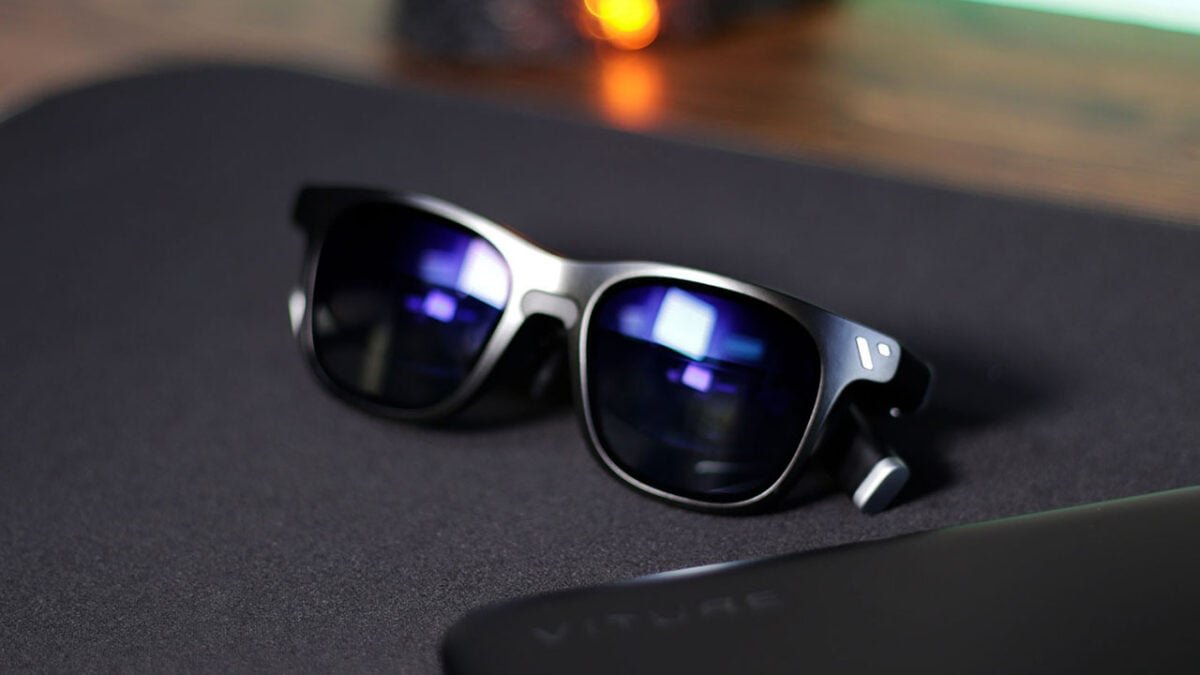There was a time when consuming media on the go meant you were limited to the confines of your phone, tablet, or even handheld game system. Further back in time, these options were even more limited, making it exceedingly hard to beat the comforts of a TV or, at best, a home theatre setup.
With the rise in popularity of wearable tech, including VR headsets like the Meta Quest 3 and Apple Vision Pro, it’s no surprise, then, that the AR and XR space has also seen a bit of a boon recently with the rise of new and novel ways to project media to your eyeballs.
The Viture One XR is a Mixed Reality, or more aptly, an Extended Reality device. This means that rather than augmenting or interacting with your environment in a 3D space, the Viture One XR is limited to projecting a screen directly in front of your field of vision.
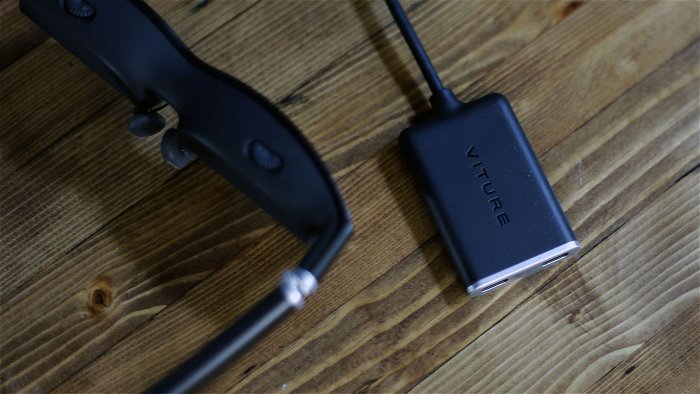
Simply put, the Viture One XR are a pair of glasses that projects a 120” 1080p screen through the power of its USB-C connection. If you’re like me and have some experience consuming media through the use of a VR headset, which, in my case, is through the Quest 2 and 3, via applications such as Skybox VR and Virtual Desktop, then the notion of massive 120” simulated screen may not be new to you.
“Simply put, the Viture One XR are a pair of glasses that projects a 120” 1080p screen through the power of its USB-C connection.”
However, the Viture One XR is not a VR experience. Instead, using the Viture One XR feels more akin to looking through the viewfinder of a camera, but one comfortably projected to both eyes. Talking specs, the Viture One XR features a resolution of 1920×1080 per eye, making it a full HD experience with a PPD rating of 50, which is relatively high comparatively but one that benefits the user by providing a sharp resolve, which helps with things such as text and finer detail which could potentially otherwise be lost when looking through the smaller aperture of the glasses.
Inside the box, the Viture One XR ships with several accessory packets, which, at first glance, can feel overwhelming, but ultimately, connecting the XR glasses to your device of choice is a straightforward process.
Outside of the Viture One XR itself, the box contains several optional brackets that can be used to attach various devices, such as the Steam Deck and Nintendo Switch, to the included power bank and HDMI hub that is required to connect the Viture One XR to any signals that require additional power. It should be noted, however, that these docks mentioned above are optional and only offer a more secure fit for those who wish to exclusively use the Viture One XR glasses with a particular device.

For devices like the Nintendo Switch or any device that uses an HDMI connection, the Viture One XR glasses must first be connected to the included power bank, which in itself features an HDMI input, USB C port for devices like the Switch, and two additional USB C ports reserved for connecting up to two sets of glasses.
The mobile dock and power bank combo feature a 13,000mAH/20W battery, which Viture claims can offer up to six additional hours of juice to devices such as the Nintendo Switch. In my testing, I found the Switch running at full capacity while the glasses themselves did not seem to drain the battery, as the mobile dock provided adequate power to both devices, even after several hours of play.
Using the Viture One XR glasses when playing on the Nintendo Switch was a fun experience and the least compromised of the bunch, as the Nintendo Switch offers a max resolution of 1080p and a 60hz refresh rate, which perfectly utilizes the XR glasses’ capabilities.
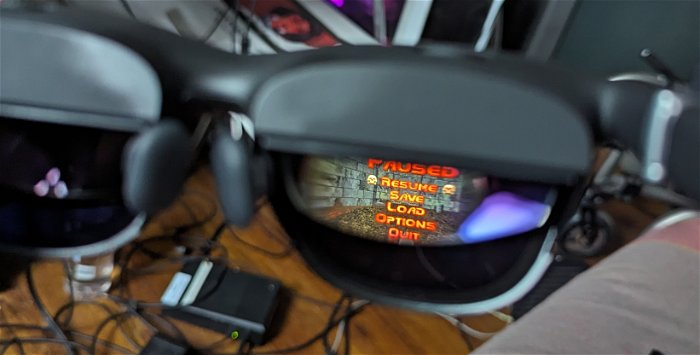
Games like The Legend of Zelda: Breath of the Wild, and even retro titles like the original Doom, to puzzle games like Lumines, all looked crystal clear and perfectly projected to the Viture One XR’s field of view, which when worn projected a floating 120” screen, with just enough clearance in your peripheral to see the world around you.
“By far, the worst thing about the Viture One XR glasses is the price of entry, which does not include the optional Android-based neckband.”
Regarding light bleed and visual noise, the Viture One XR features an optional electrochromic filter that offers three degrees of darkening, which, at its max, makes the viewing experience almost as good as watching in a dark room. And for those who truly want a theatre-like experience, the Viture One XR ships with a darkening filter that snaps onto the glasses, effectively blacking out any visual interference, perfect for viewing content at home or during an extended trip.
The Viture One XR glasses truly shine when used with mobile devices, such as a smartphone or tablet, as those styles of devices do not require the additional dock and can power the glasses just off of the USB-C connection provided by your connected device.
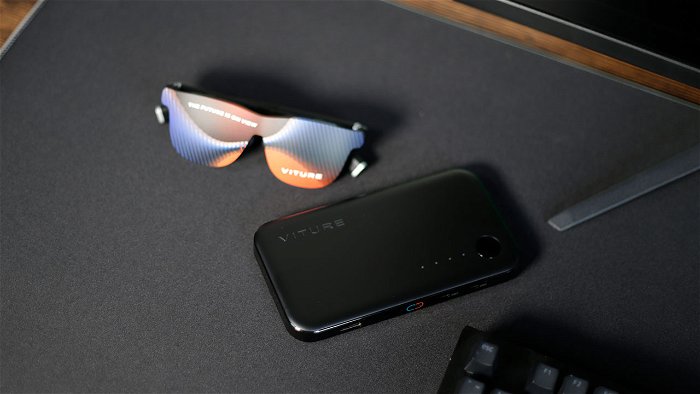
Simply plug in the Viture One XR glasses via its magnetized pogo-pin connectors to your USB-C enabled device of choice, which in my case is the 2018 iPad Pro, will project whatever is displayed on your device to your glasses. I encourage locking your device’s orientation to landscape mode to ensure you get the max real estate out of your viewing experience.
Firing up apps like YouTube and Plex offered me a wealth of content to watch in a new light, only slightly diminished by the lack of HDR support and higher resolutions like 4K. Despite the use of micro OLED technology, the lack of deep blacks and bright colours associated with an HDR-enabled image was noticeable. Still, for older content, particularly TV shows and Blu-ray rips, the Viture One XR glasses were excellent and, more importantly, comfortable.
Comfort is a big deal when talking about wearable tech, and as someone who loves consuming media in VR, even I get tired after maybe an hour or two at max. The Viture One XR may just be a screen, lacking the feature set found in a smart device, but this trade-off comes with a total weight of only 78g, making it the easy choice for using over an extended period of time.
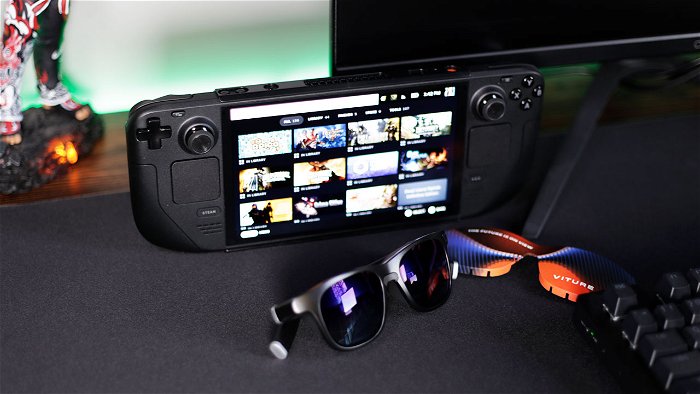
Putting on the Viture One XR and wearing it for a few hours felt similar to wearing a regular pair of shades. In terms of overall feel, the closest thing I can compare Viture’s offering to are the ill-fated active 3D glasses offered by many a TV manufacturer during the 3DTV craze of the 2010s.
The 3DOF tracking, or the ability to have the screen inside your glasses track you in 3D space, also makes wearing the Viture One XR while lounging around or in bed as simple as putting on the glasses and getting comfortable without the worry of losing tracking or having to deal with awkward VR controls or gestures.
Speaking of 3D, the Viture One XR features support for SBS 3D, which can be toggled by long pressing the button on the left temple of the frame, in addition to the volume rocker and electrochromic toggle, which can be switched between by double tapping the same button.

Gaming on my PC was where things fell apart somewhat, primarily due to the lack of a higher refresh rate, making the Viture One XR best reversed for TV and Movie consumption or on older games that don’t offer high framerate options.
By far, the worst thing about the Viture One XR glasses is the price of entry, which does not include the optional Android-based neckband. Coming in at a whopping $592 Canadian or around $400 USD when not on sale, the Viture One XR is a steep price for what is essentially a glorified floating screen compared to other devices in the same price bracket that offer more overall utility.
If you’re someone who travels a lot or has to share their screen with family, the Viture One XR are a great way to consume media, offering a larger-than-life screen with minimum fuss or compromises, but one that comes at an exceedingly high price of entry, making it a hard to recommend for everyone.
- 【See the Future: The First XR/AR Glasses With Adjustable Electrochromic Film】The first of their kind with tint-changing film, VITURE One…
